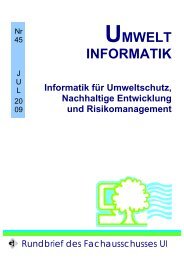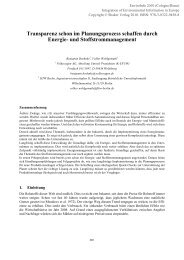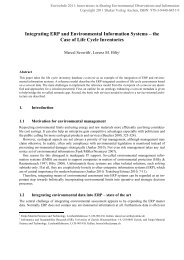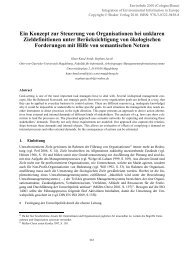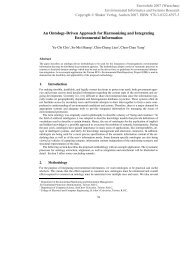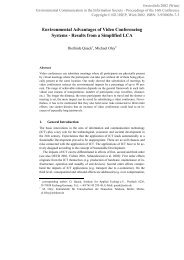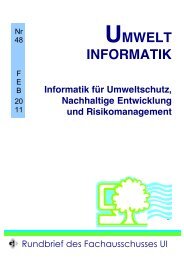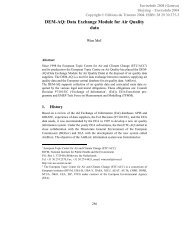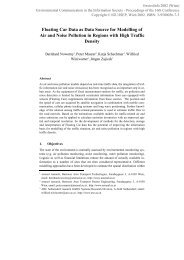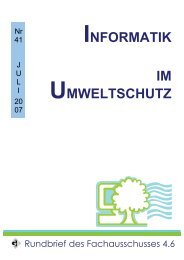Environmental ICT applications for eco-industrial ... - EnviroInfo
Environmental ICT applications for eco-industrial ... - EnviroInfo
Environmental ICT applications for eco-industrial ... - EnviroInfo
Create successful ePaper yourself
Turn your PDF publications into a flip-book with our unique Google optimized e-Paper software.
• The Journal of Industrial Ecology (JIE) published a special issue on: “Electronic commerce,<br />
the internet and the environment” in 2002. This special edition was an early attempt<br />
to pull together, and critically examine, the research on <strong>ICT</strong> and the environment.<br />
The focus was primarily on data, analysis, and reasoned interpretation<br />
(http://www3.interscience.wiley.com/journal/120133161/issue).<br />
• The 22 nd International Conference on In<strong>for</strong>matics <strong>for</strong> <strong>Environmental</strong> Protection, <strong>EnviroInfo</strong><br />
2008 in Lüneburg (Germany), was explicitly announced under the converging<br />
banner: “<strong>Environmental</strong> In<strong>for</strong>matics and Industrial Ecology”<br />
(http://www.enviroinfo2008.org/). This banner implies connections, linkages, and<br />
common characteristics between <strong>Environmental</strong> In<strong>for</strong>matics and Industrial Ecology.<br />
<strong>Environmental</strong> <strong>ICT</strong> <strong>applications</strong> like data processing techniques, simulation tools, environmental<br />
accounting systems, geographical in<strong>for</strong>mation systems (GIS), visualization<br />
modules, environmental management in<strong>for</strong>mation systems (EMIS), and reporting wizards<br />
are enablers and could be considered as facilitators <strong>for</strong> various Industrial Ecology<br />
<strong>applications</strong> like environmental monitoring and life cycle assessment, material flow<br />
analysis, environmental risk management, environmental management accounting &<br />
reporting.<br />
• The JIE (www.yale.edu/jie/cfp-ict.html) currently invites submissions <strong>for</strong> a special issue<br />
on: “<strong>Environmental</strong> <strong>applications</strong> of in<strong>for</strong>mation and communications technology<br />
(<strong>ICT</strong>)”. The call <strong>for</strong> papers is open to autumn 2009 (deadline: September 15 th ). The aim<br />
of this s<strong>eco</strong>nd special issue explicitly focused on the intersection of <strong>Environmental</strong> In<strong>for</strong>matics<br />
and Industrial Ecology is to describe innovations in <strong>ICT</strong> used <strong>for</strong> central concerns<br />
and methods of Industrial Ecology.<br />
• The International Society <strong>for</strong> Industrial Ecology (ISIE) has launched a new section on<br />
<strong>eco</strong>-<strong>industrial</strong> development (EIDC, http://www.is4ie.org/sections). This new section is<br />
particularly devoted to <strong>industrial</strong> symbiosis projects, bringing together academics and<br />
practitioners with a passion <strong>for</strong> translating concepts of Industrial Ecology theory into<br />
practice. The news was announced at the 5 th International Conference on Industrial<br />
Ecology, 2009 Lisbon (Portugal): “Transitions Towards Sustainability”.<br />
• The latest ef<strong>for</strong>t is an expert workshop: “The role of <strong>ICT</strong> in <strong>industrial</strong> symbiosis<br />
projects” (http://www.enviroinfo2009.org), embedded in the 23 rd International Conference<br />
on In<strong>for</strong>matics <strong>for</strong> <strong>Environmental</strong> Protection, <strong>EnviroInfo</strong> 2009 in Berlin (Germany).<br />
As a part of the FP7 EU project “<strong>ICT</strong>-ENSURE, http://www.ict-ensure.eu/), the<br />
objective of the expert workshop is to investigate the role of <strong>ICT</strong> in <strong>industrial</strong> symbiosis<br />
projects, and describe significant synergies that could be exploited by using innovations<br />
in <strong>ICT</strong> <strong>for</strong> <strong>industrial</strong> symbiosis projects.<br />
The milestones above could be taken as a sign <strong>for</strong> three developments: first, in both communities<br />
the issue of environmental <strong>ICT</strong> <strong>applications</strong> <strong>for</strong> <strong>eco</strong>-<strong>industrial</strong> development is regarded as of increasing<br />
relevance; s<strong>eco</strong>nd, the issue provides an excellent example that <strong>Environmental</strong> In<strong>for</strong>matics and Industrial<br />
Ecology share common features, and hence both communities may foster co-operation and<br />
joint research; third, while Industrial Ecology has its early focus in the 1980s in an engineering/technological-<br />
and resource/industry-focused bipolar view (Ayres and Ayres 1996), largely concentrated<br />
on physical phenomena, today the community has broadened its scope to the immaterial<br />
world of bits & bytes, data, in<strong>for</strong>mation, knowledge and the critical intersection with computational<br />
sciences.<br />
2. Classification scheme <strong>for</strong> environmental <strong>ICT</strong> <strong>applications</strong><br />
Currently, a vast number of environmental <strong>ICT</strong> <strong>applications</strong> is in use or under development. To obtain<br />
order in the great variety, a classification scheme is presented that helps to classify environmental <strong>ICT</strong><br />
<strong>applications</strong>. This classification scheme consists of five different approaches:<br />
• methods- and technologies-driven approach (2.1),<br />
224<br />
Copyright © Shaker Verlag 2009. ISBN: 978-3-8322-8397-1






